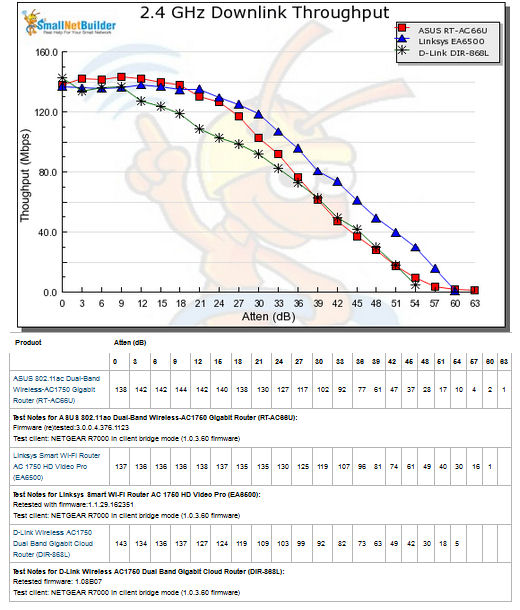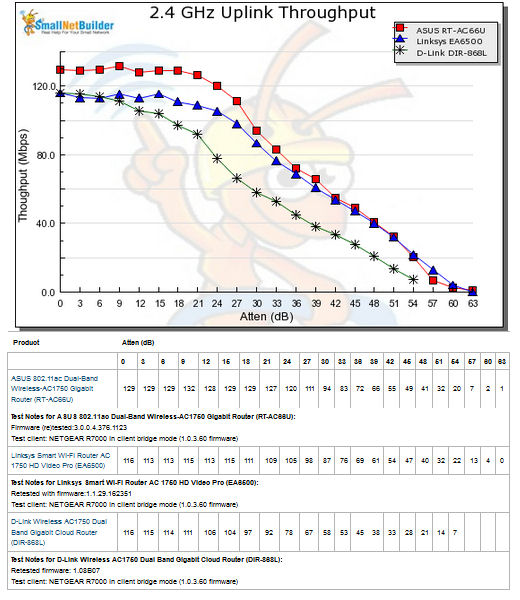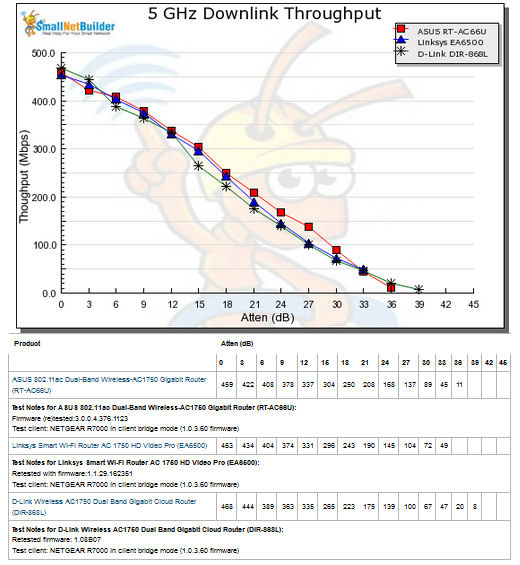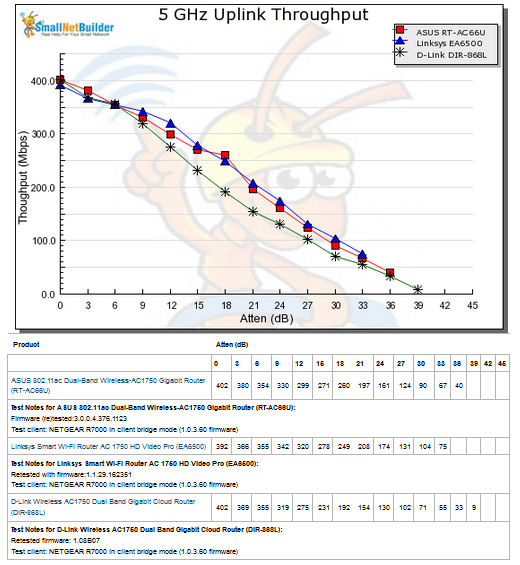Introduction
We recently changed wireless testing methodology to a new V8 Process, with the differences produced by the new process described in AC1900 Router Retest Redux. Since some buyers are still interested in AC1750 routers too, we retested a few of the more popular models, i.e.:
The NETGEAR R6300 isn’t in this retest because it’s been replaced by a V2 version. We’ll have a separate review of it up shortly.
Rather than compare the new and old AC1750 test results, I thought it would be more interesting to look at how AC1750 class routers compare to AC1900 class routers – both tested with the new testing methodology. I apologize in advance – you’ll have a few more charts to look at than we normally present, but I think that some of the data will reveal a few interesting insights.
2.4 GHz Avg. & Max.
The V8 test process uses an AC1900 class NETGEAR R7000 configured as a wireless bridge. So our 2.4 GHz results now can show the results of the higher potential link rate in that band. We still test in 20 MHz bandwidth mode, so the maximum link rate possible in our test procss, as indicated by the 11ac MCS table, is 288.9 Mbps vs. 600 Mbps possible with 40 MHz bandwidth. Still, this is a 33% potential throughput increase over the three stream 20 MHz bandwidth 802.11n link rate of 216.7 Mbps. (40 MHz bandwidth also produces the same percentage increase from 450 to 600 Mbps.)
This first chart looks at 2.4 GHz average downlink and uplink throughput. It’s interesting to note that for downlink, the results are tightly grouped with a range from 84 Mbps to 96 Mbps—only a 14% range. More interesting is that the top performing router was an AC1750 router (Linksys EA6500) and that an AC1900 router (D-Link DIR-868L) ranked near the bottom of the charts.
For uplink, all of the AC1900 class routers outperformed the AC1750 class routers. The fastest AC1750 router, at 73 Mbps, was about 13% slower than the fastest AC1900 router, about the same range as downlink.

AC1750 & AC1900 retested routers – 2.4 GHz Average Throughput
I also looked at Maximum throughput. It was really interesting to see all three of the AC1750 class routers outperform the AC1900 routers on downlink.
For 2.4 GHz uplink, the ASUS RT-AC66U placed second with 132 Mbps, compared to the top performing Linksys WRT-1900AC at 148 Mbps. The rest of the AC1900 routers outpaced the balance of the AC1750 routers. This might indicate that if your primary use of the router is on the 2.4 GHz band, you might be able to save a few dollars by buying an AC1750 router without sacrificing too much performance.

AC1750 & AC1900 retested routers – 2.4 GHz Maximum Throughput
5 GHz Avg. & Max.
For 5 GHz average downlink, it’s a completely different story. With a range from 277 Mbps to 294 Mbps, all AC1900 routers significantly outperformed the AC1750 routers that ranged from 217 Mbps to 258 Mbps. Again, the fastest AC1900 router was about 14% faster than the fastest AC1750 router (294 vs. 258 Mbps).
For 5 GHz average uplink, I was really surprised to see the Linksys EA6500, a 1750 class router, at the top of the charts at 249 Mbps. The balance of the chart is pretty much as expected. The AC1900 routers outperformed the AC1750 routers. The exception was the DIR-868L at the bottom of the charts at 193 Mbps, the maximum uplink for the balance of the AC1750/AC1900 routers were relatively tightly grouped in a range from 229 Mbps to 242 Mbps.

AC1750 & AC1900 retested routers – 5 GHz Average Throughput
For both the 5 GHz downlink and uplink maximum throughput tests, there were no surprises. All of the AC1900 class routers outperformed all the AC1750 class routers. For the downlink test, the AC1900 routers ranged from 512 Mbps (Linksys EA6900) to 481 Mbps (Linksys WRT 1900AC) The AC1750 routers ranged from 468 Mbps (D-Link DIR 868L) down to 453 Mbps (Linksys EA6500).
For 5 GHz uplink, there was a different leader at the top of the charts – the Linksys WRT1900AC at 462 Mbps. The slowest AC1900 router, the ASUS RT-AC68U, turned in 415 Mbps of maximum throughput. The top two AC1750 routers tied for fastest honors at 402 Mbps with the Linksys EA6500 bringing up the bottom of the charts at 392 Mbps.

AC1750 & AC1900 retested routers – 5 GHz Maximum Throughput
Throughput vs. Attenuation – 2.4 GHz
Focusing on just the AC1750 class routers, we’ll take a brief look at throughput vs. attenuation plots to look at the nuances of how the products perform over their entire signal operating range.
For downlink, all three routers are fairly tightly grouped between 137 and 143 Mbps at the start of the test with 0 dB of attenuation. The DIR-868L drops below the other two starting at 12 dB and stays below the pack until about 36 dB. Starting at 21 dB, the Linksys EA6500’s curve stays above and to the right (faster) than the other two until it loses connection at 60 dB.

Throughput vs. Attenuation – 2.4 GHz downlink
For 2.4 GHz uplink, the clear winner is the ASUS RT-AC66U and clear loser the D-Link DIR-868L. The ASUS started out with higher throughput than the other two and remained above the others out to 51 dB. The D-Link started to drop off at 12 dB and its plot was below and to the left (lower throughput) of the other routers until it lost connection at 57 dB.

Throughput vs. Attenuation – 2.4 GHz uplink
Throughput vs. Attenuation – 5 GHz
Surprisingly, for 5 GHz downlink, there really wasn’t a clear winner or loser. As you can see from the plots, performance started out very similar and remained that way until about 21 dB where the ASUS took a slight lead. The Linksys was the first to drop the connection at 36 dB followed by the ASUS at 39 dB. AT 33 dB, the results were still tightly grouped in the mid 40’s ranging from 45 Mbps to 49 Mbps. Thereafter, throughput dropped off rapidly with the D-Link being the last one standing at 39 dB with throughput of 8 Mbps. It dropped the connection at 42 dB of attenuation.

Throughput vs. Attenuation – 5 GHz downlink
For 5 GHz uplink, there’s a little more variation in results. The ASUS and the D-Link each start at 402 Mbps at 0 dB, with the Linksys a tad lower at 392 Mbps. Starting at 9 dB, the D-Link plot drops below the other two and stays there throughout the rest of the range. The ASUS and Linksys track fairly closely though the mid attenuation values, with the Linksys being the first to drop the connection at 36 dB followed by the ASUS at 39 dB. At 39 dB, the D-Link was the last one standing (again) with 9 Mbps of throughput, but dropped its connection at 42 dB of attenuation.

Throughput vs. Attenuation – 5 GHz uplink
Closing Thoughts
As Tim pointed out in his AC1900 retest conclusion, “The V8 wireless test process is definitely tougher than the V7. All tests are used instead of just the best test run and the 360° rotation during test makes it much more difficult for products to maintain a connection at low signal levels”. Indeed, we saw that products had difficulty with low signal conditions and dropped connections earlier—especially in the 5 GHz band.
The charts at the top of the article tell an interesting story. First, the average profiles are just that – averages, so you don’t really see the highs and lows. Interestingly, in the 2.4 GHz downlink profile, for the average and maximum, an AC1750 router topped the charts. In fact, for the downlink maximum chart, all the AC1750 class routers scored higher than the AC1900 routers. Even for the uplink average and maximum charts, the AC1750 class ASUS RT-AC66U placed second behind an AC1900 router and ahead of the other three AC1900 class routers.
The key take-away from this analysis is that higher link rate doesn’t necessarily mean higher performance, at least not in the way you might think. AC1900 routers have a higher link rate than AC1750 routers only in 2 4 GHz (600 Mbps vs. 450 Mbps). The 5 GHz link rate is the same for both classes. Yet, in our comparison, we found generally improved 5 GHz performance from the AC1900 routers, and in many cases better 2.4 GHz performance from the AC1750 class products.
In the end, it all comes down to which band you’re looking for better performance in. It also pays to shop carefully – the D-Link AC1900 (DIR-880L) is actually $5.00 cheaper than the AC1750 ASUS RT-AC66U. And the bargain is the Linksys EA6500, which Linksys told us they’re discontinuing because people buy more AC1900 routers! You can buy a refurb EA6500-RM directly from Linksys for $95 with free shipping and 30-day money back guarantee.
